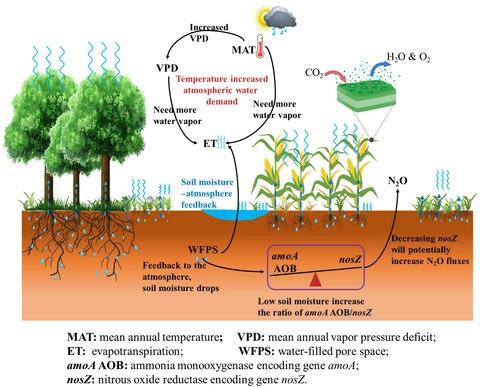当前位置:
X-MOL 学术
›
Glob. Change Biol.
›
论文详情
Our official English website, www.x-mol.net, welcomes your
feedback! (Note: you will need to create a separate account there.)
Soil moisture–atmosphere feedback dominates land N2O nitrification emissions and denitrification reduction
Global Change Biology ( IF 10.8 ) Pub Date : 2022-08-02 , DOI: 10.1111/gcb.16365 Jiayuan Liao 1, 2 , Qiqi Luo 2 , Ang Hu 3 , Wenkai Wan 1 , Dian Tian 1 , Jingwei Ma 1 , Tian Ma 2 , Hao Luo 2 , Sheng Lu 1
Global Change Biology ( IF 10.8 ) Pub Date : 2022-08-02 , DOI: 10.1111/gcb.16365 Jiayuan Liao 1, 2 , Qiqi Luo 2 , Ang Hu 3 , Wenkai Wan 1 , Dian Tian 1 , Jingwei Ma 1 , Tian Ma 2 , Hao Luo 2 , Sheng Lu 1
Affiliation

|
Soil moisture (SM) is essential to microbial nitrogen (N)-cycling networks in terrestrial ecosystems. Studies have found that SM–atmosphere feedbacks dominate the changes in land carbon fluxes. However, the influence of SM–atmosphere feedbacks on the N fluxes changes, and the underlying mechanisms remain highly unsure, leading to uncertainties in climate projections. To fill this gap, we used in situ observation coupled with gridded and remote sensing data to analyze N2O fluxes emissions globally. Here, we investigated the synergistic effects of temperature, hydroclimate on global N2O fluxes, as the result of SM–atmosphere feedback impact on N fluxes. We found that SM–temperature feedback dominates land N2O emissions by controlling the balance between nitrifier and denitrifier genes. The mechanism is that atmospheric water demand increases with temperature and thereby reduces SM, which increases the dominant N2O production nitrifier (containing amoA AOB gene) and decreases the N2O consumption denitrifier (containing the nosZ gene), consequently will potential increasing N2O emissions. However, we find that the spatial variations of soil–water availability as a result of the nonlinear response of SM to vapor pressure deficit caused by temperature are some of the greatest challenges in predicting future N2O emissions. Our data-driven assessment deepens the understanding of the impact of SM–atmosphere interactions on the soil N cycle, which remains uncertain in earth system models. We suggest that the model needs to account for feedback between SM and atmospheric temperature when estimating the response of the N2O emissions to climatic change globally, as well as when conducting field-scale investigations of the response of the ecosystem to warming.
中文翻译:

土壤水分-大气反馈主导土地 N2O 硝化排放和反硝化减少
土壤水分 (SM) 对陆地生态系统中的微生物氮 (N) 循环网络至关重要。研究发现,SM-大气反馈主导着陆地碳通量的变化。然而,SM-大气反馈对 N 通量的影响发生了变化,其潜在机制仍然高度不确定,导致气候预测的不确定性。为了填补这一空白,我们使用原位观测以及网格化和遥感数据来分析全球 N 2 O 通量排放。在这里,我们研究了温度、水文气候对全球 N 2 O 通量的协同效应,这是 SM 大气反馈对 N 通量的影响的结果。我们发现 SM 温度反馈在土地 N 2中占主导地位通过控制硝化菌和反硝化菌基因之间的平衡来排放 O。其机制是大气需水量随温度升高而降低,从而增加了主要的 N 2 O 生产硝化菌(含有amoA AOB 基因)并减少了 N 2 O 消耗反硝化菌(含有nosZ基因),因此可能会增加 N 2 O 排放。然而,我们发现,由于 SM 对温度引起的蒸汽压不足的非线性响应,土壤-水分可用性的空间变化是预测未来 N 2的最大挑战。O 排放。我们的数据驱动评估加深了对 SM-大气相互作用对土壤 N 循环影响的理解,这在地球系统模型中仍然不确定。我们建议,在估计 N 2 O 排放对全球气候变化的响应以及对生态系统对变暖的响应进行实地规模调查时,该模型需要考虑 SM 和大气温度之间的反馈。
更新日期:2022-08-02
中文翻译:

土壤水分-大气反馈主导土地 N2O 硝化排放和反硝化减少
土壤水分 (SM) 对陆地生态系统中的微生物氮 (N) 循环网络至关重要。研究发现,SM-大气反馈主导着陆地碳通量的变化。然而,SM-大气反馈对 N 通量的影响发生了变化,其潜在机制仍然高度不确定,导致气候预测的不确定性。为了填补这一空白,我们使用原位观测以及网格化和遥感数据来分析全球 N 2 O 通量排放。在这里,我们研究了温度、水文气候对全球 N 2 O 通量的协同效应,这是 SM 大气反馈对 N 通量的影响的结果。我们发现 SM 温度反馈在土地 N 2中占主导地位通过控制硝化菌和反硝化菌基因之间的平衡来排放 O。其机制是大气需水量随温度升高而降低,从而增加了主要的 N 2 O 生产硝化菌(含有amoA AOB 基因)并减少了 N 2 O 消耗反硝化菌(含有nosZ基因),因此可能会增加 N 2 O 排放。然而,我们发现,由于 SM 对温度引起的蒸汽压不足的非线性响应,土壤-水分可用性的空间变化是预测未来 N 2的最大挑战。O 排放。我们的数据驱动评估加深了对 SM-大气相互作用对土壤 N 循环影响的理解,这在地球系统模型中仍然不确定。我们建议,在估计 N 2 O 排放对全球气候变化的响应以及对生态系统对变暖的响应进行实地规模调查时,该模型需要考虑 SM 和大气温度之间的反馈。











































 京公网安备 11010802027423号
京公网安备 11010802027423号